© 2026 ALLCITY Network Inc.
All rights reserved.

No matter who the Denver Broncos’ new coach is, everyone in town wants them to modernize the offense.
We actually brought this up in a film piece back early November of 2017, as teams like the Philadelphia Eagles, Houston Texans, and Kansas City Chiefs were lighting up scoreboards with RPOs and spread looks that have ruled college football for well over a decade.
A new-school trend in NFL offenses has only become more prevalent since then, as more young quarterbacks are finding success with offenses they’re all-too-familiar with.
As we analyze Denver’s two offensive coaching candidates, Los Angeles Rams quarterbacks coach Zac Taylor and Pittsburgh Steelers offensive line coach Mike Munchak, the topic of entering the NFL’s offensive revolution colored our viewing heavily.
As John Elway searches for a coach that embodies “greatness” in a specific area of expertise, here are the schematic traits that stood out on tape from the two offenses that these position coaches derive from.
Zac Taylor and the McVay offense is rooted in old-school football
The narrative on the Rams offense being innovative is actually incorrect. This isn’t some hot take deriving from having uncovered a secret in Sean McVay’s attack, it’s widely been talked about on TV broadcasts with Al Michaels even saying “it’s kind of a throwback,” while Cris Collinsworth analyzed it on Sunday Night Football.
That said, the Rams are explosive, unpredictable, use lots of misdirection, and can control the tempo, often hurrying up the snap after they’ve converted their initial first down. It’s not a new-school RPO shotgun-spread attack but it’s effective none the less, and Zac Taylor’s exposure and familiarity with the offense is by far his biggest selling point as a young offensive mind.
What the Rams do all works off of their outside-zone running scheme in 11 personnel—meaning three receivers with a back and a tight end.
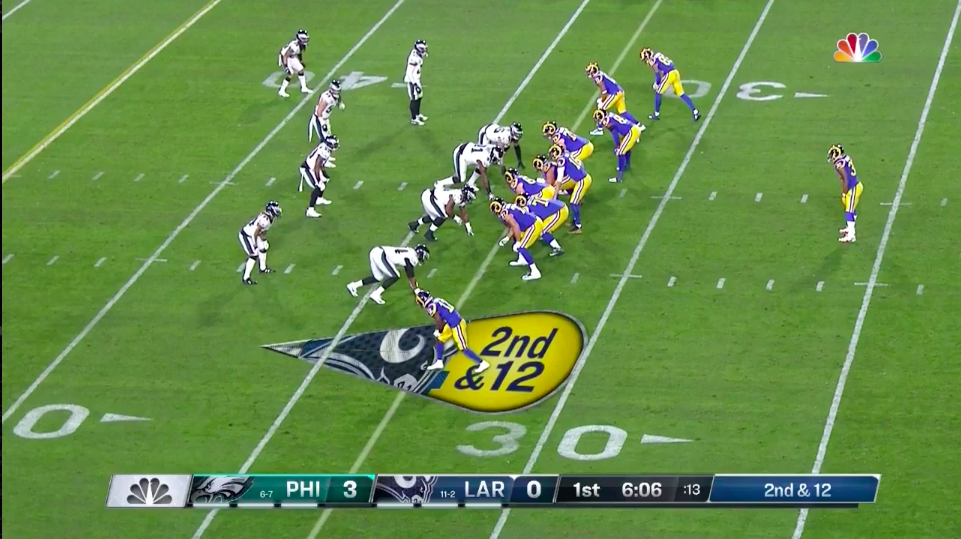
You’ll almost always see them lined up like this, with the quarterback under center—Jared Goff was under center more than any other QB in the NFL this year—with two receivers and the tight end in a bunch formation to the strong side.
Typically all the receivers will be lined up in-tight, inside the numbers which has a three-fold effect: they have more room to operate on out routes towards the sideline, can be utilized on end-around runs, and also be more involved as blockers for the running game.
It all starts with the run, where the Rams run a balanced attack with tons of zone concepts.
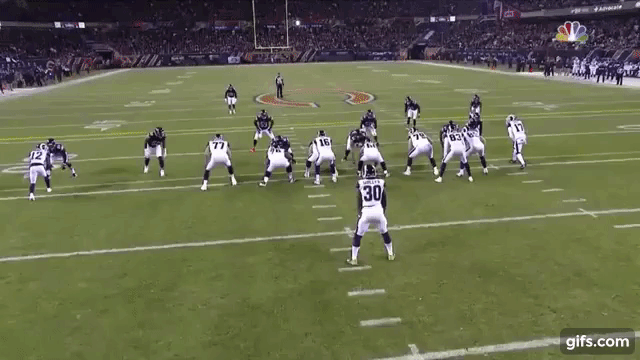
The offensive line is asked to cover a lot of ground laterally, and the RB is doing a lot of the damage on counter runs, running against the grain. As defenses are moving east-and-west with the line, that north-and-south run can be lethal.
Off of those 11-personnel bunch formations, the Rams do just about everything, which is what makes them so dangerous and unpredictable.
They’ll set up the run, then throw on play action, where Goff can often zip it to his first read—commonly on a curl or comeback route. Then they’ll throw in bootlegs, jet sweeps with their receivers, fake jet sweeps, put receivers in motion, and on it goes. From that basic look, they do all sorts of things making them incredibly difficult to defend.
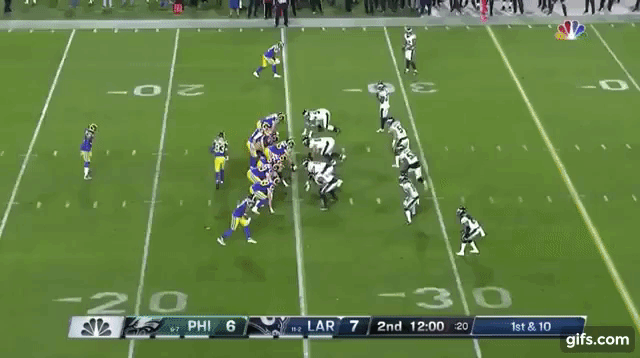
Just watch the play below, where they fake a jet sweep—a common pre-snap look they’ll implement—fake play action, put Goff on the move on a boot all just to dump it off on a screen that’s set up nicely—Todd Gurley doesn’t catch the ball on an inaccurate throw here, but the design is still terrific.
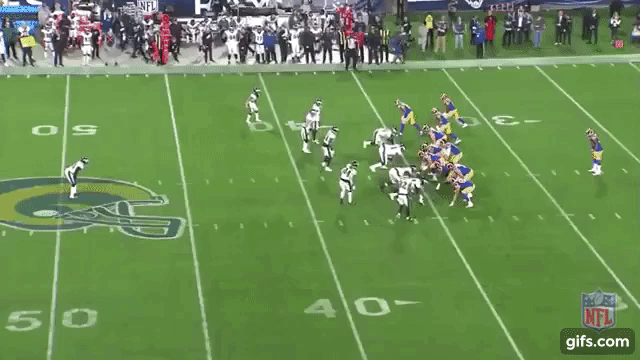
Everything looks the same pre-snap, and there’s no telling what’s coming next, making misdirection a huge part of the Rams’ success.
The play-action bootleg is a big part of the offense, too, as they’ll work off of the outside-zone run game and run a boot to the opposite side, something they’ll do with the screen game as well.
All of this manufactures easy, quick throws and reads, allowing the quarterback to make half-field reads and often just throw it to his primary read.
The Rams are also predicated on setting defenses up with short throws to then attack deep. It’s really a classic West Coast offense with lots of the concepts we’ve seen in Denver both under Mike Shanahan and Gary Kubiak in the past, with some really clever variations and tempo.
Of course, while that’s the Rams’ bread and butter, they will also spread it out on obvious passing downs out the gun.
Where Taylor becomes particularly interesting is in his experience coaching collegiately as Cincinnati’s OC back in 2016—the scoring offense was one of the worst in the country, but the passing attack actually was a top-50 unit despite multiple QB injuries—utilizing a power spread with lots of the modern looks people think of when talking about offensive innovators. With that experience, Taylor could actually update the Rams offense.
His brother, Press, is the Philadelphia Eagles’ quarterbacks coach and could be added to the staff if Taylor were to be hired. Molding the Rams attack with some of the new-school RPO stuff Philly does, would be another great way to update and diversify the McVay offense.
The Rams offense might be a throwback, but Taylor’s connections and experience could actually lead him to making it more new-school than it is. If there’s a “great” trait in the Rams young QB coach, it’s the playbook he’d bring with him from LA combined with that potential.
What has Mike Munchak learned in Pittsburgh?
Munchak has been an offensive line coach his entire life, aside from a three-year stint as the Tennessee Titans head coach, where his offenses never ranked in the NFL’s top 15 per yards or scoring.
Getting out of Tennessee has given him valuable exposure to the Steelers powerful offense, which is quite different from what we just analyzed in LA.
Munchak developed three Pro Bowl lineman this year in the Steel City, allowing the fourth-fewest sacks of any offense in the league—24, comparatively Denver allowed 34 and was 10th in this category.
His work with the line is a huge selling point, and without any play calling experience, it’s hard to know exactly what type of offense he would run. Thus, when watching film on the Steelers this year, we wanted to get a feel for what Munchak could take with him and implement in Denver.
The Steelers run a vertical passing game with lots of shotgun and four-wide looks. This allows them to isolate their best WRs outside and open up space underneath for RBs and TEs over the middle.
Just watch how Antonio Brown gets open to the right sideline on a deep 3rd-and-3 throw despite the Panthers dropping nine defenders in coverage.
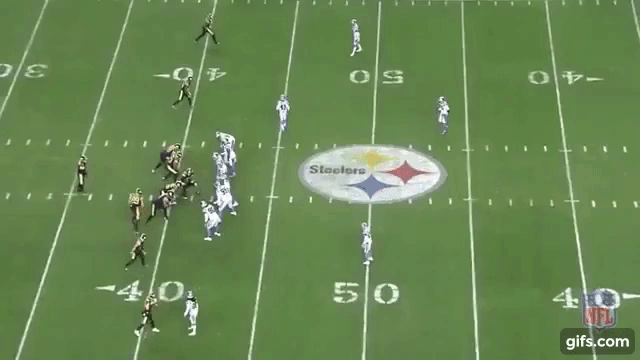
They’re an explosive passing attack that can score on the very first play of the game, as they did here in Week 10 against the Carolina Panthers, attacking with a three-wide look that confused Carolina’s aggressive cover-2 corners for a big touchdown.
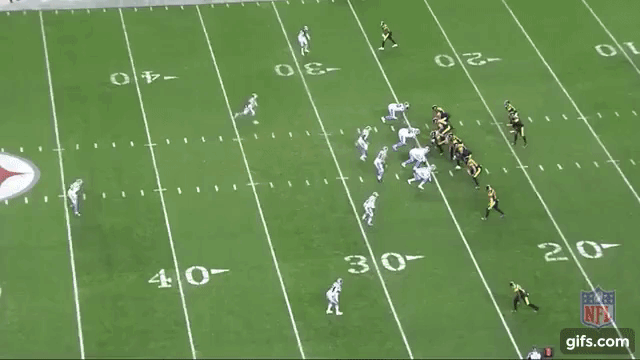
Their running game is based around a gap-run scheme, which is basically a power-running attack. The run game is predicated around attacking and overloading a certain gap to get blockers downhill to create push.
This is the type of stuff Jim Harbaugh or someone like David Shaw would use in college. It requires better OL play, or at least better coaching, and allows offenses to set the tone up front, with gaps being altered and manipulate by moving pieces.
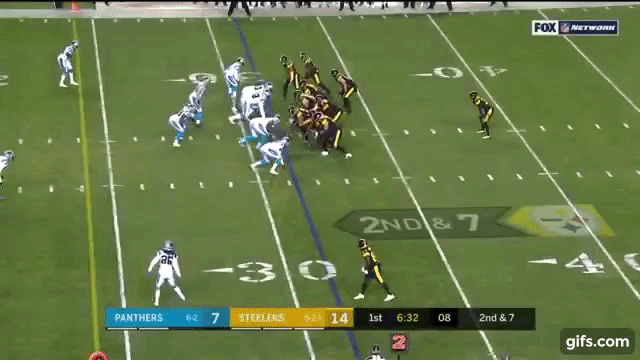
In this two-play run sequence, you can see the tight end being brought in to block and how powerful the line is at the point of attack. Regularly, when watching the Steelers film, you can see the OL blocking 5-10 yards downfield, and if they aren’t, they’re sealing off lanes with on-point angle blocks.
On a reverse like this one below, you can also see how they move well and the type of misdirection the line creates. Watch as the left guard pulls right while the center and left tackle trickle out to set up great blocks in space downfield.
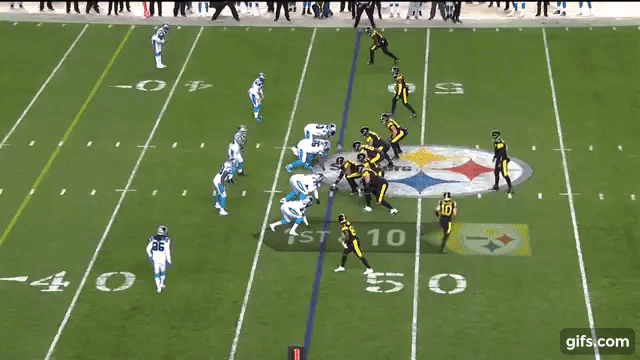
Who Munchak hires as his OC will be very interesting, especially if they have connections to this Steelers offense, which was second in the league in passing yards.
On the flip side, the Broncos in 2018 actually sported the better run game, averaging a full 0.6 yards more per carry, and only allowed 10 more sacks, despite the revolving door on the line. It’s legitimate to wonder if with all the schematic changes involved, and with the quarterback situation currently in place in Denver, would Munchak prove to be that much of an upgrade offensively if he brought over some of the Steelers concepts to the Mile High City?
Both Taylor and Munchak’s schemes are relative unknowns, given they’re both only position coaches, but if they took concepts from their current employers and implemented them in Denver, there would be a nice diversity to the offense that’s been missing, even if they wouldn’t be the new-school college schemes that have become all the rage these days.
Comments
Share your thoughts
Join the conversation



